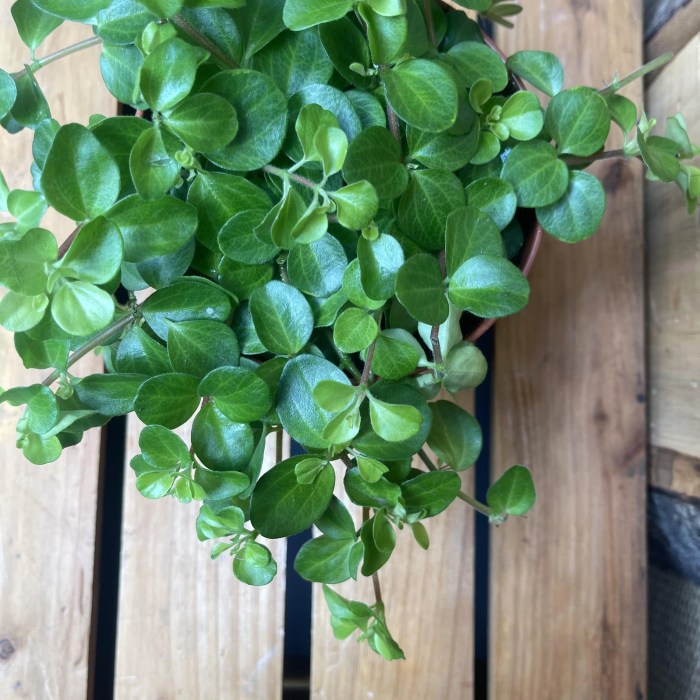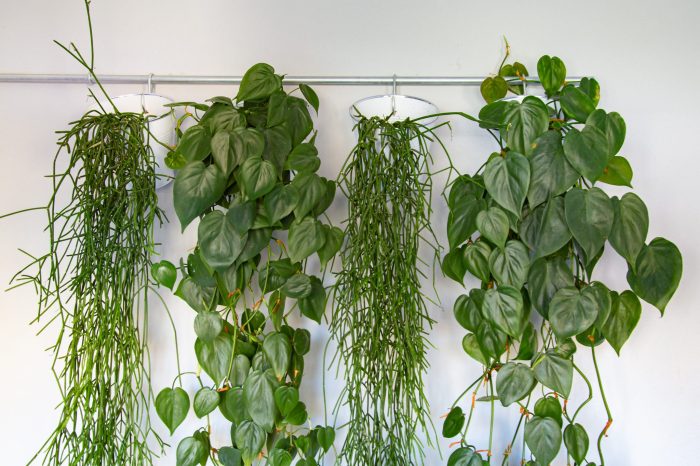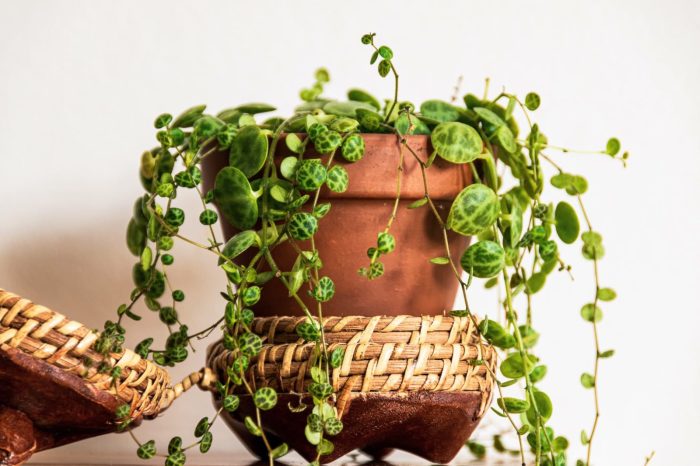Trailing house plants are a captivating addition to any home, adding a touch of greenery and creating a sense of flow. From hanging baskets to vertical gardens, these plants offer endless possibilities for enhancing interior décor and purifying the air.
In this comprehensive guide, we delve into the world of trailing house plants, providing detailed plant profiles, hanging techniques, vertical gardening tips, and comprehensive care instructions. Whether you’re a seasoned plant enthusiast or just starting your indoor gardening journey, this guide will empower you with the knowledge to create a thriving oasis in your home.
Plant Profiles

Trailing houseplants, with their cascading foliage and graceful growth habits, add a touch of elegance and greenery to any indoor space. These versatile plants come in a wide variety of species, each with its own unique characteristics and care requirements.From
the lush tendrils of the String of Pearls to the delicate fronds of the Maidenhair Fern, trailing houseplants offer a diverse range of textures, colors, and shapes to enhance any home decor. Whether you’re a seasoned plant enthusiast or a novice gardener, there’s a trailing houseplant that’s perfect for you.
String of Pearls
The String of Pearls (Senecio rowleyanus) is a popular succulent known for its long, trailing stems adorned with plump, bead-like leaves. Native to South Africa, this plant thrives in bright, indirect light and well-draining soil. Its unique appearance makes it a favorite among plant collectors.
Hanging Techniques

Hanging trailing plants adds a touch of greenery and vertical interest to any space. Various techniques can be employed, each with its advantages and disadvantages, to accommodate different plant sizes, weights, and aesthetic preferences.
Macrame
Macrame is a versatile technique that involves knotting cords or ropes to create intricate hangers. It allows for customization and can support plants of varying weights. Macrame hangers add a bohemian touch to a room and are suitable for plants with long, trailing stems, such as pothos or philodendrons.
Hanging Baskets
Hanging baskets are a classic option that provides ample space for plants to grow and spread. They come in various materials, including wicker, metal, and plastic. Baskets are suitable for larger trailing plants, such as ferns or hoyas, and can be hung from the ceiling or a wall-mounted hook.
Trellises, Trailing house plants
Trellises are vertical structures that provide support for trailing plants to climb and grow upwards. They can be made from various materials, such as wood, metal, or plastic, and can be freestanding or wall-mounted. Trellises are suitable for plants that naturally climb, such as ivy or clematis.
DIY Hanging Solutions
For those who enjoy DIY projects, there are several ways to create hanging solutions using common household items. These include:
- Macrame hangers:Use twine or yarn to knot hangers inspired by macrame techniques.
- Hanging baskets:Repurpose old baskets or bowls by attaching cords or wires for hanging.
- Trellises:Create simple trellises using wooden dowels or bamboo sticks attached to a wooden frame.
Vertical Gardening

Vertical gardening, a technique that utilizes vertical space to grow plants, offers numerous advantages. Trailing plants, with their cascading foliage, are ideal for this approach, providing both aesthetic appeal and practical benefits.
Vertical gardens with trailing plants optimize space, particularly in urban areas with limited outdoor space. They can be installed on walls, fences, or trellises, creating a lush green tapestry that transforms vertical surfaces into vibrant displays. Additionally, trailing plants act as natural air purifiers, removing toxins and pollutants from the environment.
Sample Vertical Garden Plan
To create a visually appealing vertical garden, consider a mix of trailing plants with varying colors and textures. A sample plan might include:
- Dichondra ‘Silver Falls’: With its silver-green foliage, this plant creates a cascading waterfall effect.
- Tradescantia ‘Zebrina’: Known for its variegated leaves in shades of green, purple, and silver, this plant adds a touch of color and texture.
- Hoya carnosa: This trailing succulent features thick, waxy leaves and produces clusters of fragrant flowers.
- Peperomia prostrata: With its small, round leaves, this plant creates a dense mat of foliage.
- Philodendron hederaceum: This classic trailing plant has heart-shaped leaves that add a tropical touch.
Maintenance and Troubleshooting
Maintaining a vertical garden with trailing plants requires regular care and attention:
- Watering: Water the plants thoroughly, allowing the excess to drain. Avoid overwatering, as it can lead to root rot.
- Fertilizing: Fertilize the plants monthly during the growing season with a balanced liquid fertilizer.
- Pruning: Regularly trim back any dead or overgrown stems to maintain the desired shape and size.
- Pest control: Monitor the plants for pests and diseases, and treat them promptly with appropriate methods.
- Troubleshooting: If the plants appear wilted or discolored, adjust watering, fertilizing, or sunlight exposure accordingly.
Interior Decorating
Trailing plants have become a popular choice for interior decorators as they add a touch of greenery and create a sense of flow within a space. These plants can be incorporated into various room styles, from modern to rustic, and can be used to enhance the overall ambiance of a room.
Incorporating Trailing Plants into Room Styles
Trailing plants can be incorporated into various room styles in different ways. In modern interiors, they can be used to add a touch of nature and create a sense of tranquility. In rustic interiors, they can be used to add a touch of charm and create a cozy atmosphere.
In bohemian interiors, they can be used to add a touch of whimsy and create a relaxed atmosphere.
Trailing house plants add a touch of elegance and greenery to any space. Their long, cascading stems can be trained to grow down walls or over furniture, creating a lush and inviting atmosphere. For those seeking a more vertical solution, Hanging trailing plants can be suspended from the ceiling or attached to walls, allowing them to cascade gracefully.
These plants not only add beauty to a room but also purify the air and create a sense of tranquility.
There are many different ways to incorporate trailing plants into a room. They can be hung from the ceiling, placed on shelves, or placed on the floor. They can also be used to create a living wall or to add a touch of greenery to a windowsill.
Gallery of Inspiring Images
Here is a gallery of inspiring images showcasing trailing plants in home interiors:
Plant Care and Maintenance
Maintaining the health and beauty of trailing houseplants requires regular care and attention. This includes watering, fertilizing, pruning, and repotting, along with monitoring for pests and diseases.
Watering
- Water when the top inch of soil feels dry to the touch.
- Avoid overwatering, as it can lead to root rot.
- Use room-temperature water.
- Water thoroughly, until water drains from the drainage holes.
Fertilizing
- Fertilize monthly during the growing season with a balanced liquid fertilizer.
- Follow the instructions on the fertilizer label.
- Do not overfertilize, as it can burn the roots.
Pruning
- Prune regularly to remove dead or damaged leaves and stems.
- Prune to encourage new growth and maintain a desired shape.
- Use sharp, clean shears.
Repotting
- Repot when the plant becomes rootbound or the soil becomes depleted.
- Use a pot that is slightly larger than the current one.
- Use a well-draining potting mix.
- Water the plant thoroughly after repotting.
Pests and Diseases
| Pest/Disease | Symptoms | Treatment |
|---|---|---|
| Aphids | Small, green or black insects that feed on plant sap | Treat with insecticidal soap or neem oil |
| Mealybugs | White, cottony insects that feed on plant sap | Treat with rubbing alcohol or horticultural oil |
| Spider mites | Tiny, red or brown spiders that spin webs on plant leaves | Treat with insecticidal soap or horticultural oil |
| Powdery mildew | White or gray powder on plant leaves | Treat with fungicide or neem oil |
| Root rot | Yellowing leaves, stunted growth, and soft, mushy roots | Remove infected roots and repot in fresh soil |
Outcome Summary
Incorporating trailing house plants into your home is a rewarding experience that brings beauty, freshness, and a touch of nature indoors. With proper care and maintenance, these plants will thrive, adding a vibrant and refreshing element to your living space for years to come.
Questions and Answers: Trailing House Plants
What are the most popular trailing house plants?
Some popular trailing house plants include pothos, philodendron, spider plants, and string of pearls.
How do I hang trailing plants?
Trailing plants can be hung using macrame, hanging baskets, trellises, or even DIY solutions like curtain rods or hooks.
What are the benefits of using trailing plants for vertical gardening?
Trailing plants are ideal for vertical gardening as they maximize space, purify the air, and create a lush and cascading effect.


